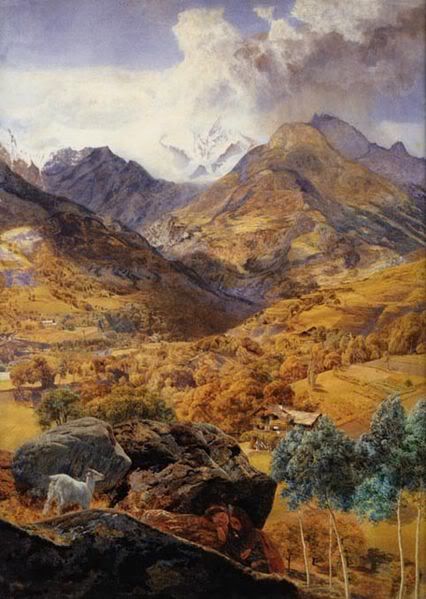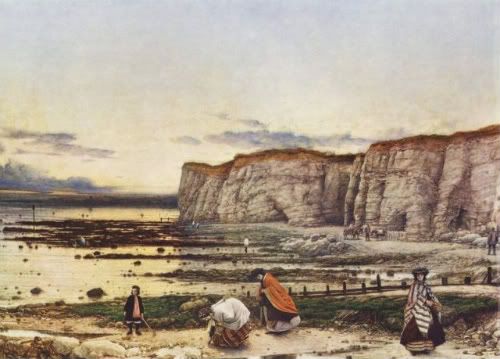My family and I enjoyed a wonderful--if slightly frenetic--weekend visiting family in Washington state. It was quite the whirlwind weekend - shopping, a wedding and visiting a couple of friends. We had a great time though. Seattle is a beautiful city, and Washington is so pretty in general...but it did go by so quickly that the whole thing was a bit of a blur. Fortunately, Edmonton was so cloudy when I got back that I feel like I'm still in Washington! The strangest part is that, even though I was only gone for a weekend, when I returned, Edmonton was already in the middle of Autumn. Trees are changing colors and losing their leaves already! I'm excited though - Fall really is one of my favourite times of year.
Thursday, September 16, 2010
Pre-Raphaelite exhibits at Oxford and Cambridge: Pre-Raphaelites and Italy and Pre-Raphaelite Portraits by John Brett
Posted by
Margaret
at
1:20 PM
5
comments
![]()
![]()
Labels: art, museums, news, pre-raphaelites, rossetti, ruskin
Friday, July 23, 2010
Endless Forms: Charles Darwin, Natural Science and the Arts
"There is grandeur in this view of life, with its several powers, having been originally breathed into a few forms or into one; and that, whilst this planet has gone cycling on according to the fixed law of gravity, from so simple a beginning endless forms most beautiful and most wonderful have been, and are being, evolved." - Charles Darwin, The Origin of the Species
I ran across the website for Endless Forms: Charles Darwin, Natural Science and the Arts while doing a search to see what connections there might have been between Charles Darwin and the Pre-Raphaelites. I saw Creation, a very interesting film about Darwin a few weeks ago. The film starred Paul Bettany and I really enjoyed it. Very nicely done, in my opinion, though I know that many may have been disappointed by it. The film focused more on Darwin's relationship with his daughter than it did on science, but the movie captured the Victorian era so well, and I loved the Gothic way the story was told, so I would recommend it. At any rate, after seeing the film it occurred to me that Darwin was a contemporary of the Pre-Raphaelites, and I wondered what they had thought of them.
But what of the other Pre-Raphaelites?
One of the more direct artistic Pre-Raphaelite responses to Darwin's work that I could find was this painting by William Dyce, which was originally part of the "Endless Forms" exhibition. The picture features the artist's family gathering fossils in Pegwell Bay, near Kent. The painting, which is held today by the Tate Gallery, uses the tail of Donati's comet to cast an ominous and uncertain mood over the scene (the comet's tail is supposed to be "barely visible" in the center of the painting - I think it's one of the white spots near the top-middle area of the picture, but I can't be sure). Dyce was a devout Anglican, so the inclusion of the comet - which, conveniently, was not due to reappear for 2,000 years - is rich with symbolism.
Posted by
Margaret
at
11:12 AM
10
comments
![]()
![]()
Labels: art, museums, pre-raphaelites, ruskin
Monday, August 3, 2009
Desperate Romantics - First Impressions
I finally had a chance to watch the first two episodes of BBC's Desperate Romantics with Javier last week. We both really enjoyed it. Overall, I found it highly entertaining (and yes, it was quite accurately described by its producer as "Entourage with easels"). The production was a bit weak on the historical front, but I suppose this was done by the writers to broaden the appeal of the series.
The series focuses on the early years of the Pre-Raphaelite Brotherhood and follows their rise to fame.
I was pleasantly surprised with the casting, particularly that of Lizzie Siddal. The actress who plays Lizzie not only resembles Siddal a great deal, but she also does an excellent job of bringing life and pathos to the character. John and Effie Ruskin are also well-cast, and are more developed than I had anticipated, although the endless speculation about what was wrong with their marriage always gets to me--honestly, nobody has any idea what the problem was (biographers seem to constantly return to the idea that Ruskin was disgusted by Effie's body hair, but how could they know?). Nevertheless, much like the rumours about Michael Jackson, I suppose this gossip is just too juicy for scriptwriters to pass up.
Unfortunately, the characterization of most of the other major players is rather simplistic, though it is in keeping with the rest of the shows' approach. Aidan Turner is handsome and energetic as Dante Gabriel Rossetti, if a bit one-dimensional. William Holman Hunt's character certainly seems to have drawn the short straw in terms of personality. Most biographers of the Pre-Raphaelites tend to consider Hunt a bit of a blowhard, but he's painted with such a broad brush in this production that it borders on the ridiculous. I hope that the writers will add some nuance to his character in the remaining episodes. Perhaps the most promising character so far is that of John Everett Millais, who is played by Samuel Barnett. Millais' character is quite endearing, and it looks like we will be seeing more of him in tonight's episode.
The character I could sort of do without is Fred Walters--a fictional hanger-on that is meant to function as a bit of a window into the lives of the PRB. He's sort of an amalgamation of a number of real-life members of the brotherhood, but I really wish that they had included William Michael Rossetti in the story instead. William Michael has always seemed quite interesting to me, and he certainly did a great deal to contribute to the visibility of the Brotherhood. I suppose the writers felt that adding in another member of the Rossetti family would rob Dante Gabriel of some of his mystique, but I digress.
Overall, I'm definitely enjoying the series. It's so nice to finally see the lives of the Pre-Raphaelites dramatized! Desperate Romantics may fall a bit short on historical accuracy, but the story of the Pre-Raphaelite Brotherhood is so inherently exciting that the show can't help but be enormously entertaining.
I'd be extremely interested to hear from others who've had a chance to see the first few episodes. What were your first impressions? Were you pleased or disappointed? Do you think the show will revive interest in the Pre-Raphaelites?
Posted by
Margaret
at
11:31 AM
11
comments
![]()
![]()
Labels: millais, news, pre-raphaelites, reviews, rossetti, ruskin, william holman hunt
Monday, June 29, 2009
Desperate Romantics
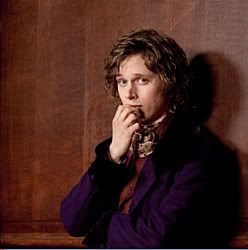
At long last, some additional news has broken about the BBC television adaptation of Franny Moyle's Pre-Raphaelite potboiler, Desperate Romantics. After months with no news, cyberspace finally has a fresh injection of stories about the much-anticipated series.
One of the more interesting articles I came across was Rapid Talent's interview with Samuel Barnett, who will be playing John Everett Millais. Barnett describes getting acquainted with his character through field trips to the National Gallery:
"I like all sorts of art, that's why I love wandering around The National Gallery. I really admire paintings that look like an actual snapshot – I think that's just extraordinary. That's what's so special about Millais: flesh – people's actual skin – looks real, for example in The Order Of Release and Christ In The House Of His Parents; it's photographic, it doesn't matter how close you get to the painting, you don't see the brushwork. With Millais's paintings it's microscopic; when he does hair it's extraordinary, you can see every strand. His paintings are my favourites – not just because I'm playing him – I think he's the best artist of the group, technically and also emotionally."
I would have to agree, though, as you all know, I have a great appreciation for Burne-Jones and Rossetti as well.
Although I'm a little disappointed that the BBC feels it's necessary to portray the Pre-Raphaelites as prototypes for modern models and rock stars, I suppose it makes it makes sense from a marketing perspective. And, in all honesty, I must admit that I was always drawn to that aspect of their story. As Barnett points out, the Pre-Raphaelites came on the scene just as the public was gaining greater access print publications than ever before:
"You don't have to know anything about the period or the artists; it's a human story and a 'sex, drugs and rock 'n' roll' story as well: this was the period when supermodels and celebrity was born. The use of the printing press meant everyone, nationally and internationally, could see these guys' paintings and the models they used, that was a first – art had never had exposure like that before."
You can read the full story at Rapid Talent UK.
Also, special thanks to Grace at The Beautiful Necessity for bringing to my attention the fact that news stories about Desperate Romantics are finally starting to get out!
Posted by
Margaret
at
8:17 AM
7
comments
![]()
![]()
Labels: edward burne-jones, millais, news, pre-raphaelites, rossetti, ruskin
Sunday, February 8, 2009
Cast of "Desperate Romantics" announced by the BBC
The BBC Press Office has finally released the casting information for their upcoming series, Desperate Romantics. Most of the actors historically inspired TV dramas are much better looking than their historical counterparts and I'm not complaining. However, the BBC definitely took some rather extreme artistic liberties with this one.
First up: Dante Gabriel Rossetti will be played by Aiden Turner. We all know that Rossetti was a bit of a lady killer, but he wasn't exactly top model material. The producers have chosen to gloss over this a bit and have chosen an impossibly attractive young man to play Rossetti. While I fail to see much of a resemblance between him and Rossetti (other than the fact that both of them have brown hair!), I'm pretty sure Rossetti would approve. After looking at his photograph, take a look at his self-portrait. Rossetti doesn't seem to have had a problem with portraying himself as more attractive than he actually was (though, in his defence I'm sure years of drug abuse had taken a toll on his boyish good looks in this photo).
Dante Gabriel Rossetti, in the flesh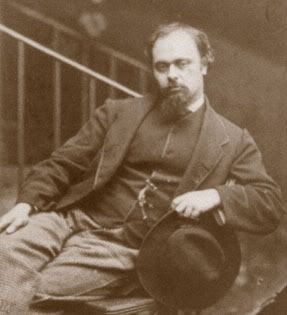
Rossetti's self portrait: 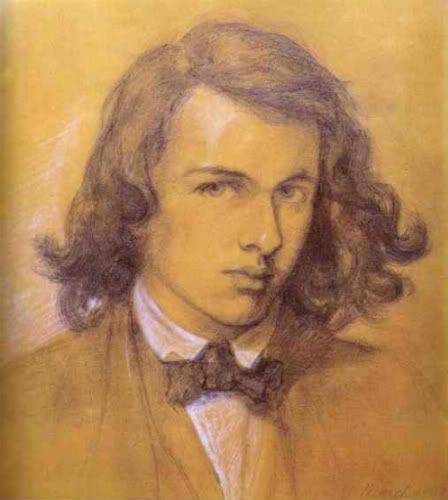
And finally, his cinematic alter ego : 
Correction: it's not that Aidan Turner, it's this one: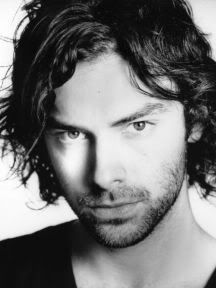
(And thank you to whoever pointed out which Aidan Turner will actually be starring in Desperate Romantics! A little less soap-opera-ish and a lot more believable.)
And now for the rest of the cast.
Tom Hollander (who bears little resemblance to John Ruskin--for one thing, he's a bit chubby and Ruskin was practically anorexic) will be playing Ruskin, the famous art critic and patron of the Pre Raphaelites. This casting decision still makes sense to me,though, as Hollander often plays snobby, self-absorbed types. At the same time, I hope he doesn't overdo it. Ruskin was certainly interesting, even if he was obsessed with his work and had a rather odd way of relating to women.
In more casting news, Samuel Barnett will be playing John Millais, and Zoe Tapper will be playing Effie Ruskin (who later leaves Ruskin to be Mrs. Millais).
Amy Manson has been cast as Pre-Raphaelite "stunner" Lizzie Siddal, Sam Crane as Fred Walters and Jennie Jacques will play Annie Miller. Rafe Spall will also take a turn as PRB founding member William Hunt.
All in all, I predict that the script will be frothy melodrama and the cast will be easy on the eyes. Not a problem, as far as I'm concerned. There's no denying that the Pre-Raphaelites are ripe for soap opera-esque treatment. I just hope that the series will revive public interest in the Pre-Raphaelite and Arts and Crafts movements.
Posted by
Margaret
at
10:14 AM
20
comments
![]()
![]()
Labels: lizzie siddal, pre-raphaelites, rossetti, ruskin, william holman hunt
Wednesday, January 14, 2009
Desperate Romantics by Franny Moyle
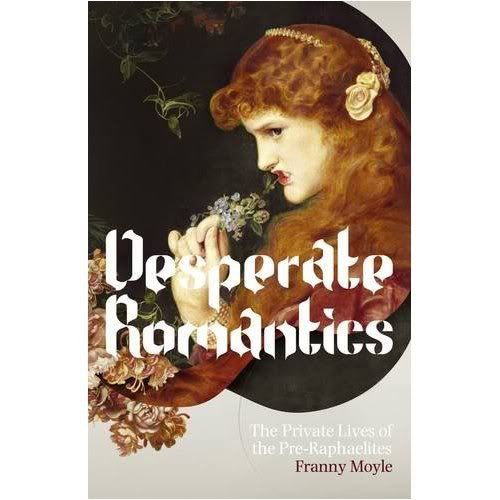
Franny Moyle's new book, Desperate Romantics, catalogues the lives and loves of the Pre-Raphaelites, while occasionally touching on their art. The book, which serves as the inspiration for the upcoming BBC miniseries of the same name, sounds like it will be a delight for those looking to dwell on the shallower aspects of the Pre-Raphaelite movement.
First, I will confess that the bohemian lifestyle of the Pre-Raphaelites has held a certain fascination for me ever since I first picked up Beth Russell's Traditional Needlepointand suddenly found myself entranced by the beauty of Morris and Rossetti's art and the sordid details of their personal lives. Whether for good or ill, the countless affairs, intrigues, love triangles and suicides that pepper the Pre-Raphaelite movement have undeniably added to their allure.
It still seems a shame that the book ignores the Pre-Raphaelites' art almost entirely, in favour of tabloid coverage of their exploits. There is so much more to the Pre-Raphaelite vision than sultry models and randy artists. William Morris himself was a fascinating man with beautiful ideas that are still pertinent today. The same is also true for the inspiring John Ruskin, who is sidelined as a mere deviant in Moyle's work. In her defence, however, I notice that Moyle is a television producer, which probably explains her conviction that sex is the best way to sell art. And perhaps she's right. It certainly worked for me. Today my interest in the Pre-Raphaelites goes far beyond their sordid personal lives, but in the beginning, their fascinating lives were instrumental in drawing me into their world.
For more information, read the Times review of Desperate Romantics
Posted by
Margaret
at
10:28 AM
8
comments
![]()
![]()
Labels: books, jane morris, news, rossetti, ruskin, william morris
Thursday, November 27, 2008
Priceless Pre-Raphaelite Painting Found in Dusty Attic
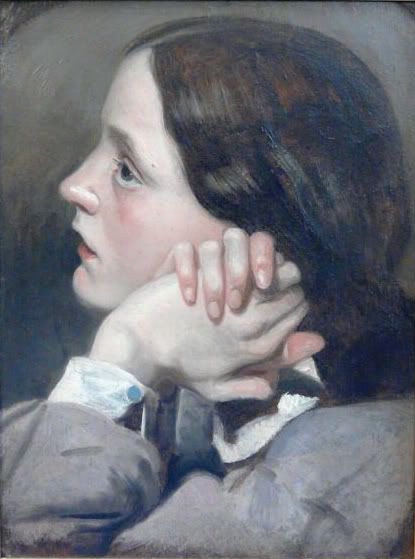
A woman in Somerset, England, recently discovered this rare portrait by John Everett Millais of his wife, Effie Millais, while she was in the process of cleaning her house.
How come stuff like this never happens to me?
Apparently, she had received the painting as a birthday gift when she was just nine years old (now that was one spoiled child!), and then forgot about it. The man who was evaluating the rest of her belongings, Duncan Chilcott, described his discovery:
"Up in the attic she wanted me to look at a table. On the other side of the room behind some old mattresses I saw the painting leaning against the wall," the Telegraph quoted him as saying.
"It was covered in thick dust and I was astonished when I blew it off and saw what was beneath."
"The lady selling it said it was purchased for her by her mother as a ninth birthday present."
Mr. Chilcott's wife later added that when the woman was informed of the painting's value, she was rather nonplussed:
"she wasn't leaping up and down but she was surprised by it. I guess it is cash in the attic for her."Perhaps her mother would have been better off getting her a bicycle for her birthday and keeping the fine art for herself.
While the owner might not be excited about the paintings' discovery, the art world is quite excited. You will recall that Effie Millais was actually married to the art critic John Ruskin before she met Millais. Because Effie's hand is hidden in this portrait, there is some speculation that it has something to do with John and Effie's relationship (or, as the Daily Mail more provocatively stated it, the "scandal of a love triangle"). The painting will be auctioned on December 9.
Read the whole story at the Daily Mail
Posted by
Margaret
at
7:10 PM
10
comments
![]()
![]()
Labels: millais, news, pre-raphaelites, ruskin
Thursday, September 4, 2008
Ruskin and Sandro Botticelli
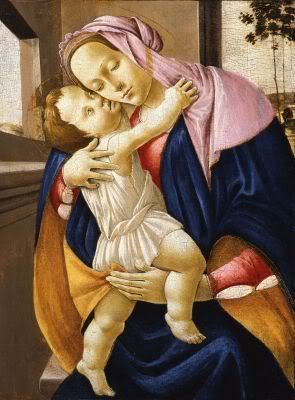
John Ruskin was actually one of the first people associated with the Pre-Raphaelites to have rediscovered Botticelli, but the reason it isn't written about much is that Ruskin's initial reaction to Botticelli was tepid at best. After hearing about Botticelli from some friends in the aesthetic movement, Ruskin had his assistant Fairfax Murray purchase Botticelli's Virgin and Child for a mere 300 pounds in 1877 (can you even imagine having an original Botticelli for a mere 600 dollars? Even in 1870s dollars, that was a tremendous bargain), but when the painting arrived, Ruskin wrote Murray that the Bottecelli was "so ugly that I've dared not show it to a human soul. Your buying such an ugly thing has shaken my very trust in you"(145).
Ruskin was so disgusted with Murray's purchase that he left the painting out of his writings entirely. Nevertheless, Ruskin renewed his interested in Botticelli later in life, when his friend Edward Burne-Jones became a fan. In 1872 Ruskin travelled to Rome to examine Bottecelli's frescoes at the Sistine Chapel up close, and returned two years later to study them again. As time went by, he slowly began to see Botticelli as an important figure representing the continuity between the Greek and Christian traditions. I wonder if he ever warmed up to the Bottecelli he had in his own private collection? (The painting is now held by the Ashmolean Museum, Oxford).
Robert Hewison. Ruskin, Turner and the Pre-Raphaelites. London: Tate Gallery Publishing, 2000.
Posted by
Margaret
at
6:16 AM
7
comments
![]()
![]()
Labels: pre-raphaelites, ruskin
Friday, August 22, 2008
John Ruskin's Elements of Drawing

I first discovered John Ruskin through a badly battered edition of Elements of Drawing that was my constant companion from the ages of 10-16. I don't even remember where I found it the first time (did my mom buy it used? I have no idea), but at any rate I dragged it with me every time I went to sketch something. I loved it because it made it seem like drawing was something accessible to anyone, and it had great pictures that didn't intimidate me. Plus, it was written so simply that even a child could understand it, in spite of Ruskin's warning on the first page of the preface:
In the first place, the book is not calculated for the use of children under the age of twelve or fourteen. I do not think it advisable to engage a child in any but the most voluntary practice of art. If it has talent for drawing, it will be continually scrawling on what paper it can get; and should be allowed to scrawl at its own free will, due praise being given for every appearance of care, or truth in its efforts.
I remember feeling quite self important for using the book long before I was "supposed to", although looking back, I was basically engaged in "continually scrawling," rather than any serious study. At any rate, I just adored the book, which I took great delight in dragging to the woods with me whenever I wanted to go investigate sketching opportunities.
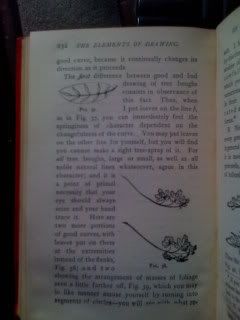
It wasn't until much later that I figured out that the John Ruskin who had written my handy little book was the same John Ruskin who had been one of the most famous art critics of the 19th century. I still remember reading about the Elements of Drawing--it was like a light bulb went on in my head. I ran to my bookcase, and sure enough, it was the same book! I was a little surprised--it seemed like such a simple little book.
151 years after it was published, The Elements of Drawing is still in print today, and it's no surprise. It's an amazing introduction to drawing and the world of art that is a perfect gift for anyone (plus, it has great pictures!). The entire book is constructed like a series of letters to an aspiring artist, and its conversational tone is a large part of its appeal. Plus, the reader is treated like an artist from the first page of a book--and is congratulated on tasks as simple as drawing a line. It's a classic book, and one I would recommend it to anyone, whether they draw or not!
The Ruskin watercolour shown above is Rocks and Ferns in a Wood at Crossmount, Perthshire, 1847.
Posted by
Margaret
at
12:12 PM
11
comments
![]()
![]()
Labels: ruskin
Tuesday, August 12, 2008
William Holman Hunt "Our English Coasts"
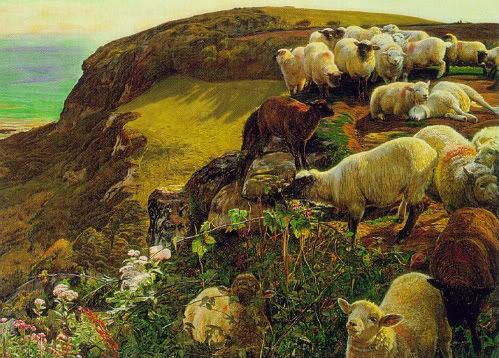
In the wake of the popularity of the The Hireling Shepherd, William Holman Hunt was asked by Charles T. Maud to paint another picture featuring the wayward sheep. In 1852, William Holman Hunt began work on Our English Coasts (also known as Strayed Sheep).
Hunt used the cliffs of Fairlight, east of Hastings, as the background for the work. You will recall that William the Conqueror, a Norman (French) invader, triumphed over the English forces at the battle of Hastings in 1066, forever changing the course of English history and introducing feudalism into England.
Hunt's choice of Hastings as the setting for his painting was certainly not a coincidence. Symbolism was so important to the Pre-Raphaelites that it seems very unlikely that Hunt would have chosen to portray a flock of "sheep" wandering precariously over the cliffs near Hastings if he hadn't intended to convey a deeper message. As a result, many have interpreted the painting as symbolic of fears of the French invading England. Interestingly, the Duke of Wellington, Arthur Wellesley, famed for his defeat of Napoleon at the Battle of Waterloo, died while Hunt was in the process of completing the painting.
The painting is also reminiscent of Alfred Lord Tennyson "Ode on the Death of the Duke of Wellington," especially these two lines:
Remember him who led your hosts;
He bade you guard the sacred coasts (VII, 21-22)
Whatever the deeper meaning behind the painting, it left a significant impression on art critic John Ruskin (who had defended Hunt's earlier work as well). When Our English Coasts was first exhibited, Ruskin praised the painting highly in his lecture series, The Art of England. Ruskin remarked that "it showed to us for the first time in the history of art, the absolutely faithful balances of colour and shade by which actual sunshine might be transposed into a key in which the harmonies possible with material pigments should yet produce the same impressions upon the mind which were caused by the light itself"(33.272-3).
As with Hunt's other early paintings, what is striking about this work is the near-photographic detail. The flowers and leaves in the background are done with incredible precision. Even the veins in the sheep's ears are lifelike! It's a really spectacular composition on so many levels. One of the things I really like about this painting is that it reminds us that the Pre-Raphaelites didn't just paint pictures of knights and ladies! There are so many beautiful landscapes done by artists in the Pre-Raphaelite vein that deserve more attention.
Posted by
Margaret
at
10:09 AM
5
comments
![]()
![]()
Labels: pre-raphaelites, ruskin, william holman hunt

